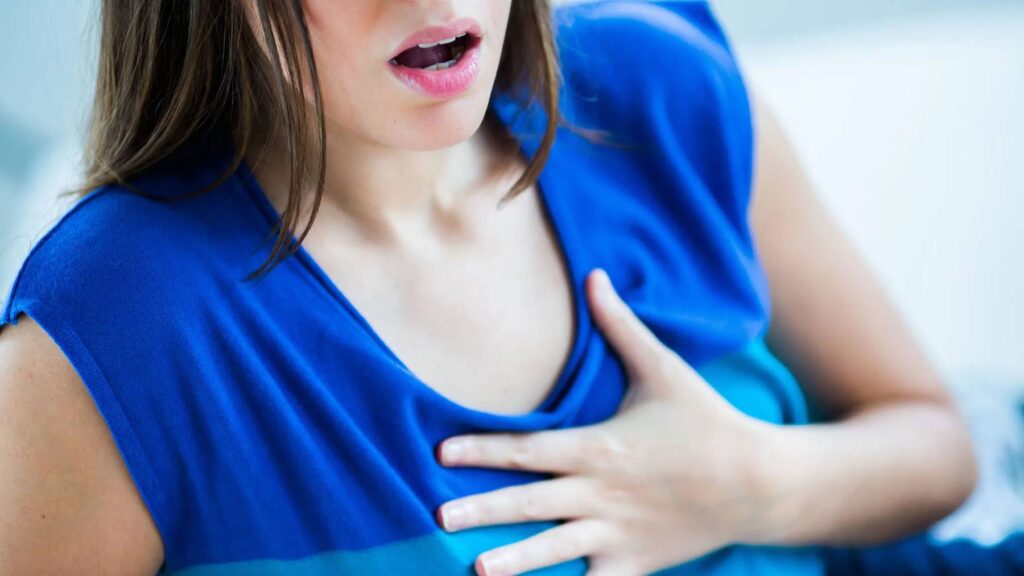Are you a woman in your 30s or 40s who feels like heart problems are a concern for later in life? While heart disease is often thought of as a problem for older adults, heart attacks in women can happen at any age, and the symptoms are often different from what we expect.
Many women may experience subtle or less obvious signs of a heart attack, which can make it harder to recognize early on. Understanding these early signs is crucial because timely intervention can save lives. In this blog, we’ll discuss the common and less obvious heart attack symptoms in women, how they differ from men’s symptoms, and what you can do to protect your heart. Keep reading to learn how to recognize the first signs of a heart attack and take control of your heart health today.
Contents
How Heart Attacks Affect Women Differently
 Heart attacks in women are often under-recognized because the symptoms can be more subtle or atypical compared to men. While chest pain is a common symptom in both men and women, women may experience it less frequently or in a different way. Instead of sharp, intense chest pain, women might feel discomfort, tightness, or pressure in the chest. In some cases, women may not feel chest pain at all.
Heart attacks in women are often under-recognized because the symptoms can be more subtle or atypical compared to men. While chest pain is a common symptom in both men and women, women may experience it less frequently or in a different way. Instead of sharp, intense chest pain, women might feel discomfort, tightness, or pressure in the chest. In some cases, women may not feel chest pain at all.
Additionally, hormonal differences and heart disease risk factors unique to women (such as pregnancy complications or menopause) can make it harder to spot a heart attack early. Many women report feeling unusual fatigue or nausea days before a heart attack, which might be mistaken for stress, flu, or other non-heart-related issues.
Common Symptoms of a Heart Attack in Women
 Here are some of the key symptoms that women should watch out for:
Here are some of the key symptoms that women should watch out for:
- Chest Pain or Discomfort: This may feel like tightness, pressure, or a squeezing sensation rather than sharp pain.
- Fatigue: Extreme tiredness or feeling unusually weak, especially without exertion.
- Nausea or Vomiting: Feeling nauseous or actually vomiting, which is often mistaken for indigestion.
- Shortness of Breath: Difficulty breathing, even when at rest or with minimal exertion.
- Back, Jaw, or Neck Pain: Unexplained pain or discomfort in these areas can sometimes be a sign of a heart attack in women.
- Sweating: Unexplained, excessive sweating without physical exertion.
- Dizziness or Lightheadedness: Feeling faint or dizzy can accompany other heart attack symptoms.
If you experience any of these symptoms, especially if they come on suddenly or get worse, it’s important to seek immediate medical attention. Early detection and timely intervention are key to improving heart health outcomes.
Why Women May Experience Heart Attack Symptoms Differently

Women often experience heart attack symptoms differently than men due to a variety of physiological and hormonal factors. These differences can make it more difficult to recognize a heart attack early on, which can delay treatment and increase the risk of complications. Here’s why:
Hormonal Differences
-
Estrogen, a hormone that women have in higher levels before menopause, plays a protective role in heart health by helping to maintain healthy blood vessels. After menopause, when estrogen levels decrease, the risk of heart disease increases, and women may start experiencing symptoms of heart problems, such as fatigue or shortness of breath, that are less typical in men.
-
Women who are pregnant or have gestational diabetes may also be at higher risk for heart disease, which can cause more subtle heart attack symptoms during later stages of pregnancy or after childbirth.
Heart Size and Structure
-
Women’s hearts tend to be smaller than men’s, which can affect how blood flows through the heart and how it responds during a heart attack. This can lead to more mild or vague symptoms, such as discomfort in the chest, rather than severe pain.
-
The smaller size of women’s coronary arteries may also make blockages harder to detect in standard diagnostic tests, leading to more frequent silent heart attacks that are harder to identify.
Nervous System Differences
-
Women’s autonomic nervous systems (which regulate involuntary functions like heart rate and blood pressure) can react differently to stress and emotional factors. These reactions can cause heart attack symptoms such as chest tightness or shortness of breath to be triggered by emotional stress, making it harder to recognize a physical heart attack.
Greater Likelihood of ‘Silent’ Heart Attacks
-
Studies show that silent heart attacks, where a person doesn’t experience the typical chest pain, are more common in women than men. These types of heart attacks often present with mild symptoms like fatigue, nausea, and dizziness—symptoms that are easy to confuse with other conditions, especially in women.
Risk Factors Unique to Women
-
Conditions such as polycystic ovary syndrome (PCOS), menopause, and pregnancy complications (like pre-eclampsia) can increase the risk of heart disease in women and lead to symptoms that aren’t immediately recognized as heart-related.
Preventing Heart Attacks in Women
 Heart disease is preventable, and taking steps to improve your heart health early on can significantly reduce your risk of a heart attack. Here are some effective strategies for preventing heart attacks in women:
Heart disease is preventable, and taking steps to improve your heart health early on can significantly reduce your risk of a heart attack. Here are some effective strategies for preventing heart attacks in women:
- Eat a balanced diet rich in fruits, vegetables, whole grains, and lean proteins like fish and legumes.
- Limit your intake of processed foods, sugary drinks, saturated fats, and salt, as these can contribute to high cholesterol and high blood pressure.
- Focus on heart-healthy fats, such as omega-3 fatty acids, found in foods like salmon, walnuts, and flaxseeds, which help reduce inflammation and lower heart disease risk.
- Aim for at least 150 minutes of moderate exercise (like brisk walking, cycling, or swimming) each week.
- Practice stress-reducing techniques such as yoga, deep breathing, meditation, or even regular walks to help manage stress levels.
- Ensure you’re getting enough sleep each night, as poor sleep is linked to higher blood pressure and heart disease.
- Regularly check your blood pressure and cholesterol levels. High blood pressure and high cholesterol are major risk factors for heart disease and heart attacks.
- If necessary, take medications as prescribed by your doctor to keep your blood pressure and cholesterol within a healthy range.
- Maintain a healthy weight
- Quit smoking
- Limit alcohol consumption
- Visit your doctor regularly to monitor your heart health and discuss any concerns or symptoms you may be experiencing.
By making these lifestyle changes, women can significantly reduce their risk of a heart attack and improve overall heart health. Starting these habits early in life is key to preventing heart disease and living a long, healthy life.
How To Treat Heart Attacks?
 Treating a heart attack quickly and effectively is critical to saving lives and minimizing heart damage. Here are the main treatment approaches used during and after a heart attack:
Treating a heart attack quickly and effectively is critical to saving lives and minimizing heart damage. Here are the main treatment approaches used during and after a heart attack:
1. Immediate Emergency Care
- If you suspect a heart attack, call emergency services immediately. Early treatment improves survival and reduces heart muscle damage.
- Emergency care often includes oxygen therapy, pain relief, and medications like aspirin to reduce blood clotting.
2. Medications
- Blood Thinners (Anticoagulants): Prevent new clots from forming and stop existing clots from growing.
- Thrombolytics (Clot Busters): These drugs dissolve clots blocking the arteries during a heart attack.
- Beta-Blockers: Help reduce heart workload and prevent further damage by slowing the heart rate.
- ACE Inhibitors: Lower blood pressure and reduce strain on the heart.
- Statins: Help lower cholesterol and stabilize plaque buildup in arteries.
3. Surgical Procedures
- Angioplasty and Stenting: A catheter with a balloon is used to open blocked arteries, often followed by placing a stent to keep the artery open.
- Coronary Artery Bypass Grafting (CABG): Surgery that reroutes blood flow around blocked arteries using vessels from other parts of the body.
4. Cardiac Rehabilitation
- After a heart attack, a structured rehabilitation program helps patients recover through supervised exercise, education, and counseling on lifestyle changes.
- Cardiac rehab improves heart function, reduces symptoms, and lowers the risk of another heart attack.
5. Lifestyle Changes Post-Treatment
- Long-term management involves adopting a heart-healthy diet, regular exercise, quitting smoking, and controlling risk factors like high blood pressure and diabetes.
Timely treatment combined with ongoing care and lifestyle changes is essential for a full recovery and reducing the risk of future heart problems. Always follow your healthcare provider’s advice closely after a heart attack.
Conclusion
A heart attack is a serious medical emergency that requires immediate attention. Quick treatment can save your life and limit damage to your heart. After a heart attack, following your doctor’s advice on medications, lifestyle changes, and rehabilitation is crucial for recovery and preventing future attacks.
If you or a loved one experience symptoms of a heart attack, don’t hesitate—seek medical help right away. And for ongoing support and expert guidance on heart health, connect with a trusted cardiologist.
Click the button below to consult with an experienced online cardiologist through MantraDoc and take charge of your heart health today!

